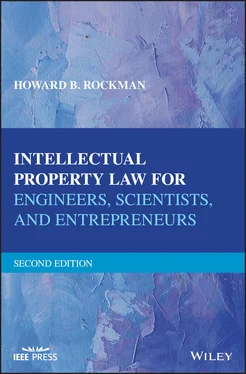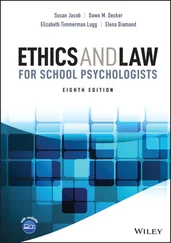The patent concludes with one or more numbered single‐sentence statements, or “claims,” which particularly point out and distinctly claim the subject matter that the applicant regards as the invention. These claims form the “heart” of the patent, and are normally written in “non‐prose” terms that the average reader may find cumbersome to read. The claims define a specific point or points of novelty embodied in the invention. The claims must also recite the specific non‐novel structure necessary to properly “locate” or support the elements of novel structure of the invention. As will be discussed in Chapter 10, the objective of a patent’s claims is to define the elements of the invention in terms such that the claims cover any related or competitive device or method developed in the future falling within the same product or process category, and at the same time each claim must not cover or “read on” the vast body of relevant prior art, or prior technology, that preceded the invention. Therefore, the claims set forth the narrow point of “invention” that is fenced off to define the exclusive rights of the inventor.
As discussed previously, a patent is not a trademark or copyright or trade secret, these being distinct additional elements of intellectual property protection ostensibly having little to do with one another. Whether goods are patented or not has nothing to do with the rights afforded by trademark law, and the same can be said of the interface between copyright and patent law.
A copyright permits the copyright owner to exclude others from copying the copyrighted material, such as books, plays, music, sculptures, motion pictures, television programs, computer programs, etc. Copyright protection does not extend to an underlying invention which, for example, might be described in the copyrighted material. Thus, a copyright could be used to prevent others from copying a book describing an invention, but the copyright cannot be used to prevent someone from using the knowledge set forth in the book and then making, using, or selling the invention. That restriction would have to be found in a patent.
It is also very important to understand that owning a patent on an invention does not confer the right to make, use, sell, offer to sell, or import the invention. What is granted is strictly the legal right to exclude others from doing so. For example, a patent may be obtained on an invention, the manufacture and sale of which can infringe a different patent owned by someone else. This is an important concept. You may obtain a patent on your invention—however, your invention may also infringe a broader patent of a prior inventor. The classic illustration I use is where you have a patent on a chair, without arms, and I decide to improve your chair by adding arms to the chair. You have your patent on your chair; I now have a patent on the chair plus the arms. However, every time I manufacture a chair with arms under my patent, I am infringing your patent on the chair per se. Another example of a patent not assuring the inventor that the invention can be introduced is a new drug that is patented, since the U.S. Food and Drug Administration requires approval before any drug is marketed to the public.
A patent is not self‐enforcing. The government issues the patent, but will not take any positive action on behalf of the patent owner to enforce the inventor’s rights established by the patent. The government simply grants the owner of the patent the right to exclude others from practicing the invention, and leaves it to the patent owner to enforce the patent in the courts. The Constitution of the United States provides the Federal Judicial System, through which patent enforcement can be obtained.
Since a patent simply grants the intangible right to exclude, its value rests entirely upon the utility and importance of the invention, and the desire of others to use it or to be in possession of the right to exclude. For example, someone may desire to buy the patent from its owner. The patent is simply a document, and not an invention. The invention is that which is described and claimed in the patent.
A patent, and the information that it discloses, cannot be kept secret. An essential aspect of obtaining a patent is that a full and complete disclosure of the invention needs to be made, so that others may practice the invention upon expiration of the patent without having to go through undue experimentation. U.S. patent applications are published 18 months after filing, unless no foreign corresponding patent applications will be filed. Patent applications, if published, are held secret in the USPTO until the date of publication, and, if not published, until the patent is issued after the examination process. However, issued patents and published patent applications are freely available to the public, with certain limited exceptions where national security is involved. The patent grant does give the right to the inventor to not commercialize the invention, or to refuse to allow others to commercialize the invention by a refusal to grant licenses. However, the patent itself issues as a public document available to all. Thus, inventions themselves may be suppressed by keeping the technology out of the public eye, but patents can neither be kept secret nor suppressed.
A U.S. patent is limited in enforcement to the 50 states of the United States and its territories and possessions. A U.S. patent cannot be enforced in Canada, Japan, Europe, or any other foreign country. However, a U.S. patent may be used to stop the importation of products that infringe the patent from abroad into the United States. Also, if a U.S.‐patented method is used to manufacture a product overseas, the product made by that method may be stopped from entering the United States by enforcement of the U.S. method patent against the importer of the product, even though the infringing method was not used in the United States.
The United States has ratified several treaties that provide significant advantages for those seeking foreign patent protection, based on a patent application initially filed in the United States. Remember, at present, there is no such thing as an international patent; patents must be obtained in each of the countries or regions in which patent protection is sought. At present, there is a single European patent.
3.6 INVENTIONS RELATING TO ATOMIC WEAPONS
As part of the Atomic Energy Act of 1954, the U.S. Congress enacted a separate law covering inventions that have utility solely relating to nuclear material or atomic weapons. This statue appears at 42 U.S.C. §2181, and is entitled “Inventions Relating to Atomic Weapons.” Section 2181(a) states: “No patent shall hereafter be granted for any invention or discovery which is useful solely in the utilization of special nuclear material or atomic energy in an atomic weapon. Any patent granted for any such invention or discovery is revoked, and just compensation shall be made therefore.” Section (b) of the statute states that: “No patent hereafter granted shall confer any rights with respect to any invention or discovery to the extent that such invention or discovery is used in the utilization of special nuclear material or atomic energy in atomic weapons. Any rights conferred by any patent heretofore granted for any invention or discovery are revoked to the extent that such invention or discovery is so used, and just compensation shall be made therefore.”
The statute also provides a definition of an “atomic weapon.” Note that if an invention can be used in an atomic weapon, but it also has non‐weapon utility, a patent may issue. However, the patent may be held up in the secrecy division of the USPTO, preventing the inventor from commercializing the invention.
Читать дальше












